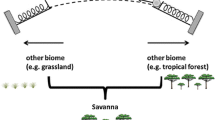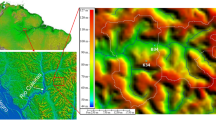Abstract
Fire scars have the ability to radically alter the surface energy budget within a tropical savanna by reducing surface albedo, increasing available energy for partitioning into sensible and latent heat fluxes and increasing substrate heat flux. These changes have the potential to alter boundary-layer conditions and ultimately feedback to local and regional climate. We measured radiative and energy fluxes over burnt and unburnt tropical savanna near Howard Springs, Darwin, Australia. At the burnt site a low to moderate intensity fire, ranging between 1,000 and 3,500 kW m−1, initially affected the land surface by removing all understorey vegetation, charring and blackening the ground surface, scorching the overstorey canopy and reducing the albedo. A reduction in latent heat fluxes to almost zero was seen immediately after the fire when the canopy was scorched. This was then followed by an increase in the sensible heat flux and a large increase in the ground heat flux over the burnt surface. Tethered balloon measurements showed that, despite the presence of pre-monsoonal rain events occurring during the measurement period, the lower boundary layer over the burnt site was up to 2°C warmer than that over the unburnt site. This increase in boundary-layer heating when applied to fire scars at the landscape scale can have the ability to form or alter local mesoscale circulations and ultimately create a feedback to regional heating and precipitation patterns that may affect larger-scale processes such as the Australian monsoon.
Similar content being viewed by others
References
Australian Government Bureau of Meteorology (2004) Climatic averages, Northern Territory. http://www.bom.gov.au/climate/averages/ Cited May 2004
Beringer J, Packham D, Tapper NJ (1995) Biomass burning and resulting emissions in the Northern Territory, Australia. Int J Wildland Fire 5(4):229–235
Beringer J, Hutley LB, Tapper NJ, Coutts A, Kerley A, O’Grady PO (2003) Fire impacts on surface heat, moisture and carbon fluxes from a tropical savanna in northern Australia. Int J Wildland Fire 12:1–8
Braithwaite RW (1991) Aboriginal fire regimes of monsoonal Australia in the 19th century. Search 22:247–249
Chambers SD, Chapin III FS (2003) Fire effects on surface-atmosphere energy exchange in Alaskan black spruce ecosystems:Implications for feedbacks to regional climate. J Geophys Res D:Atmos 108:1–17
Chambers SD, Beringer J, Randerson JT, Chapin III FS (2005) Fire effects on net radiation and energy partitioning:Contrasting responses of tundra and boreal forest ecosystems. J Geophys Res 110:D09106
Cole NM (1986) The Savannas:biogeography and geobotany. Academic Press, London, 438
Doran JC, Shaw WJ, Hubbe JM (1995) Boundary-layer characteristics over areas of inhomogeneous surface fluxes. J Appl Meteorol 34:559–571
Eugster W, Rouse WR, Pielke R, McFadden JP, Baldocchi DD, Kittel TGF, Chapin III FS, Liston G, Vidale PL, Vaganov E, Chambers S (2000) Land-atmosphere energy exchange in arctic tundra and boreal forest:available data and feedbacks to climate. Glob Change Biol 6(1):84–115
Fuchs M, Tanner CB (1968) Calibration and field test of soil heat flux plates. Soil Sci 32:326–328
Görgen K, Lynch AH, Marshall AG, Beringer J (2006) The impact of abrupt land cover changes by savanna fire on northern Australian climate. J Geophys Res D:Atmos 111:D19106
Hoffmann WA, Jackson RB (2000) Vegetation-climate feedbacks in the conversion of tropical savanna to grassland. J Climate 13:1593–1602
Hoffmann WA, Schroeder W, Jackson RB (2003) Regional feedbacks among fire, climate, and tropical deforestation. J Geophys Res D:Atmos 108:4–11
Honrath RE, Owen RC, Val Martín M, Reid JS, Lapina K, Fialho P, Dziobak MP, Kleissl J, Westphal DL (2004) Regional and hemispheric impacts of anthropogenic and biomass burning emissions on summertime CO and O3 in the North Atlantic lower free troposphere. J Geophys Res 109:D24310
Huang X, Lyons TJ, Smith RCG (1995) Meteorological impact of replacing native perennial vegetation with annual agricultural species. Hydrol Process 9:645–654
Hutley LB, O’Grady AP, Eamus D (2000) Evapotranspiration from Eucalypt open-forest savanna of Northern Australia. Functional Ecol 14:183–194
Johnson BJ, Miller GH, Fogel ML, Magee JW, Gagan MK, Chivas AR (1999) 65,000 Years of vegetation change in central Australia and the Australian summer monsoon. Science 284:1150–1152
Kilinc M, Beringer J (2007) Spatial and temporal distribution of lightning strikes and their relationship with vegetation type, elevation and fire scars. J Climate 20:1161–1173
Knowles J (1993) The influence of forest fire induced albedo differences on the generation of mesoscale circulations. Dissertation, Colorado State University, 84 pp
Lyons TJ, Schwerdtfeger P, Hacker JM, Foster IJ, Smith RCG, Huang X (1993) Land–atmosphere interaction in a semiarid region:the Bunny Fence experiment. B Amer Meteorol Soc 74:1327–1334
Lyons TJ (2002) Clouds prefer native vegetation. Meteorol Atmos Phys 80:131–140
McMillen RT (1988) An eddy correlation technique with extended applicability to non-simple terrain. Bound-Lay Meteorol 43:231–245
Miranda AI, Ferreira J, Valente J, Santos P, Amorim JH, Borrego C (2005) Smoke measurements during Gestosa-2002 experimental field fires. Int J Wildland Fire 14:107–116
O’Grady AP, Eamus D, Hutley LB (1999) Transpiration increases during the dry season:patterns of tree water use in eucalypt open-forests of northern Australia. Tree Physiol 19:591–597
Russell-Smith J, Allan G, Thackway R, Rosling T, Smith R (2000) Fire management and savanna landscapes in Northern Australia. In:Russell-Smith J, Hill GE, Djoeroemana S, Myers BA (eds) Fire and sustainable agricultural and forestry development in eastern Indonesia and Northern Australia. Australian Centre for International Agricultural Research, Canberra, 237 pp
Segal M, Cramer JH, Pielke RA, Garratt JR, Hildebrand P (1991) Observational evaluation of the snow breeze. Mon Weather Rev 119:412–424
Wardle R, Smith I (2004) Modeled response of the Australian monsoon to changes in land surface temperatures.~Geophys Res Lett 31:L16205, doi:10.1029/2004GL020157
Williams A, Cook GD, Ludwug JA, Tongway D (1997) Torch, trees, teeth and tussocks:disturbance in the tropical savannas of the Northern Territory. In: Klomp N, Lunt ID (eds) Frontiers in ecology:building the links. Elsevier Science, Oxford, pp 334
Williams RJ, Gill AM, Moore PHR (1998) Seasonal changes in fire behaviour in a tropical savanna in Northern Australia. Int J Wildland Fire 8(4):227–239
Williams AAJ, Karoly DJ, Tapper NJ (2001) The sensitivity of Australian fire danger to climate change. Climatic Change 49:171–191
Williams RJ, Griffiths AD, Allan G (2002) Fire regimes and biodiversity in the wet-dry tropical savanna landscapes of northern Australia. In: Bradstock RA, Williams JA, Gill AM (eds) Flammable Australia:the fire regimes and biodiversity of a continent. Cambridge University Press, Cambridge, UK, pp 425
Williams RJ, Hutley LB, Cook GD, Russell-Smith J, Edwards A, Chen X (2004) Assessing the carbon sequestration potential of mesic savannas in the Northern Territory, Australia:approaches, uncertainties and potential impacts of fire. Functional Plant Biol 31:415–422
Wotawa G, Trainer M (2000) The influence of Canadian forest fire on pollutant concentration in the United States. Science 288:324–328
Author information
Authors and Affiliations
Corresponding author
Rights and permissions
About this article
Cite this article
Wendt, C.K., Beringer, J., Tapper, N.J. et al. Local boundary-layer development over burnt and unburnt tropical savanna: an observational study. Boundary-Layer Meteorol 124, 291–304 (2007). https://doi.org/10.1007/s10546-006-9148-3
Received:
Accepted:
Published:
Issue Date:
DOI: https://doi.org/10.1007/s10546-006-9148-3




